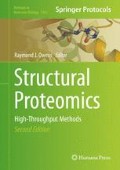Abstract
G-protein-coupled receptors (GPCRs) are not only the largest protein family, but as a whole, they represent the largest group of therapeutic drug targets. Recent successes in the determination of GPCR structures have relied on the stabilization of receptors to overcome the difficulties in expression and purification. Although a large quantity of purified protein is needed for structural determination, the majority of wild-type GPCRs are too unstable to express and purify on a large scale. Therefore, rapid screening of highly expressed stable receptor “variants” is crucial. It has been demonstrated that fusing green fluorescent protein (GFP) to a target membrane protein facilitates the evaluation of the physical properties of the membrane protein in detergent. Furthermore, the budding yeast Saccharomyces cerevisiae enables rapid construction of an expression vector via its own efficient homologous recombination system. Herein, we describe the protocols for rapid construction and screening of stable GPCR variants using GFP and S. cerevisiae.
Access this chapter
Tax calculation will be finalised at checkout
Purchases are for personal use only
References
Fredriksson R, Lagerstrom MC, Lundin LG, Schioth HB (2003) The G-protein coupled receptors in the human genome form five main families. Phylogenetic analysis, paralogon groups, and fingerprints. Mol Pharmacol 63:1256–1272
Overington JP, Al-Lazikani B, Hopkins AL (2006) How many drug targets are there? Nat Rev Drug Discov 5:993–996
Newstead S, Kim H, von Heijne G et al (2007) High-throughput fluorescent-based optimization of eukaryotic membrane protein overexpression and purification in Saccharomyces cerevisiae. Proc Natl Acad Sci U S A 104:13936–13941
Kawate T, Gouaux E (2006) Fluorescence-detection size-exclusion chromatography for precrystallization screening of integral membrane proteins. Structure 14:673–681
Shiroishi M, Tsujimoto H, Makyio H et al (2012) Platform for the rapid construction and evaluation of GPCRs for crystallography in Saccharomyces cerevisiae. Microb Cell Fact 11:78
Shimamura T, Shiroishi M, Weyand S et al (2011) Structure of the human histamine H(1) receptor complex with doxepin. Nature 475:65–70
Kota J, Gilstring CF, Ljungdahl PO (2007) Membrane chaperone Shr3 assists in folding amino acid permeases preventing precocious ERAD. J Cell Biol 176:617–628
Drew D, Newstead S, Sonoda Y et al (2008) GFP-based optimization scheme for the overexpression and purification of eukaryotic membrane proteins in Saccharomyces cerevisiae. Nat Protoc 3:784–798
Roth CB, Hanson MA, Stevens RC (2008) Stabilization of the human beta2-adrenergic receptor TM4-TM3-TM5 helix interface by mutagenesis of Glu122(3.41), a critical residue in GPCR structure. J Mol Biol 376:1305–1319
Rosenbaum DM, Cherezov V, Hanson MA et al (2007) GPCR engineering yields high-resolution structural insights into beta2-adrenergic receptor function. Science 318:1266–1273
Chun E, Thompson AA, Liu W et al (2012) Fusion partner toolchest for the stabilization and crystallization of G protein-coupled receptors. Structure 20:967–976
Serrano-Vega MJ, Magnani F, Shibata Y, Tate CG (2008) Conformational thermostabilization of the beta1-adrenergic receptor in a detergent-resistant form. Proc Natl Acad Sci U S A 105:877–882
Ito K, Sugawara T, Shiroishi M et al (2008) Advanced method for high-throughput expression of mutated eukaryotic membrane proteins in Saccharomyces cerevisiae. Biochem Biophys Res Commun 371:841–845
Author information
Authors and Affiliations
Corresponding authors
Editor information
Editors and Affiliations
Rights and permissions
Copyright information
© 2015 Springer Science+Business Media New York
About this protocol
Cite this protocol
Shiroishi, M., Kobayashi, T. (2015). Screening of Stable G-Protein-Coupled Receptor Variants in Saccharomyces cerevisiae . In: Owens, R. (eds) Structural Proteomics. Methods in Molecular Biology, vol 1261. Humana Press, New York, NY. https://doi.org/10.1007/978-1-4939-2230-7_9
Download citation
DOI: https://doi.org/10.1007/978-1-4939-2230-7_9
Published:
Publisher Name: Humana Press, New York, NY
Print ISBN: 978-1-4939-2229-1
Online ISBN: 978-1-4939-2230-7
eBook Packages: Springer Protocols

